Unit - 5
Working Capital Decisions
The term Working Capital also called gross working capital refers to the firm’s aggregate of current assets and current assets are these assets which can be convertible into cash within an accounting period, generally a year. Accounting Standards Board, The Institute of Chartered Accountants of India defines, “Working capital means the funds available for day-to-day operations of an enterprise. It also represents the excess of current assets over current liabilities including short-term loans.”

Working capital has two concepts:
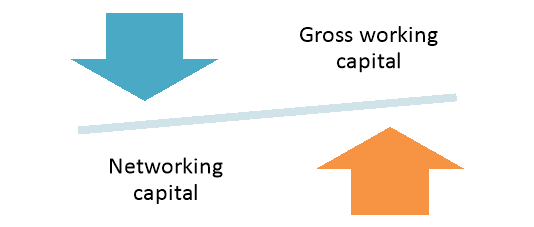
Figure: Concept of working capital
i) Gross working capital
Gross Working capital refers to the total of the current assets. Gross working capital is more helpful to the management in managing each individual current assets for day-to-day operations.
Ii) Net working capital
Net working capital refers to the excess of the current assets over current liabilities. In the long run, it is the net working capital that is useful for the purpose.
There are two types of working capital-

Figure: Working capital classification
(a) Rigid, fixed, regular or permanent working capital
Every business concern has to maintain certain minimum amount of current assets at all times to carry on its activities efficiently and effectively. It is indispensable for any business concern to keep some material as stocks, some in the shape of work-in-progress and some in the form of finished goods. Permanent Working Capital is the irreducible minimum amount of working capital necessary to carry on its activities without any interruptions. It is that minimum amount necessary to outlays its fixed assets effectively.
(b) Variable, seasonal, temporary or flexible working capital
Temporary working capital is that amount of current assets which is not permanent and fluctuating from time to time depending upon the company’s requirements and it is generally financed out of short term funds. It may also high due to seasonal character of the industry as such it is also called seasonal working capital.
Nature of Working Capital
Working capital is works as breath of the company without which an organisation cannot survive. Some of the features of working capital are-
- It is of two types- gross working capital and net working capital.
- It is permanent and temporary nature. Permanent working capital is needed for long term and short term working capital is needed for short term.
- It is used for purchase of raw materials, payment of wages and expenses.
Iv. It changes form constantly to keep the wheels of business moving.
v. Working capital enhances liquidity, solvency, creditworthiness and reputation of the enterprise.
Vi. It generates the elements of cost namely: Materials, wages and expenses.
Vii. It enables the enterprise to avail the cash discount facilities offered by its suppliers.
Key takeaways
- The term Working Capital also called gross working capital refers to the firm’s aggregate of current assets and current assets are these assets which can be convertible into cash within an accounting period, generally a year
The finance manager must keep in mind following factors before estimating the amount of working capital.
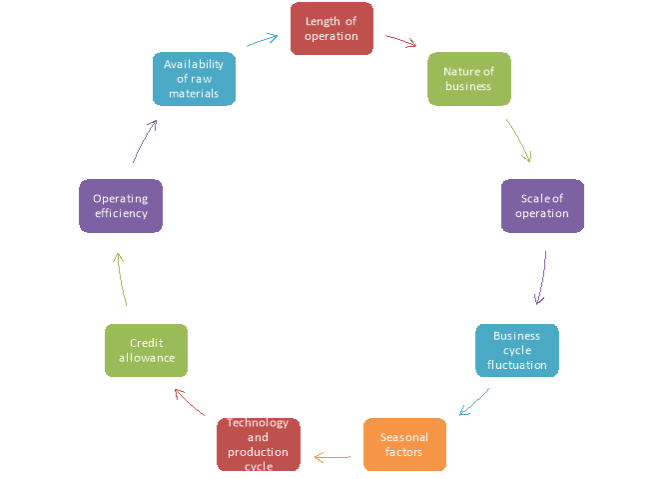
Figure: Factors affecting working capital
1. Length of Operating Cycle:
The amount of working capital directly depends upon the length of operating cycle. Operating cycle refers to the time period involved in production. It starts right from acquisition of raw material and ends till payment is received after sale. The working capital is very important for the smooth flow of operating cycle. If operating cycle is long then more working capital is required whereas for companies having short operating cycle, the working capital requirement is less.
2. Nature of Business:
The type of business, firm is involved in, is the next consideration while deciding the working capital. In case of trading concern or retail shop the requirement of working capital is less because length of operating cycle is small. The wholesalers as compared to retail shop require more working capital as they have to maintain large stock and generally sell goods on credit which increases the length of operating cycle. The manufacturing company requires huge amount of working capital because they have to convert raw material into finished goods, sell on credit, maintain the inventory of raw material as well as finished goods.
3. Scale of Operation:
The firms operating at large scale need to maintain more inventory, debtors, etc. So, they generally require large working capital whereas firms operating at small scale require less working capital.
4. Business Cycle Fluctuation:
During boom period the market is flourishing so more demand, more production, more stock, and more debtors which mean more amount of working capital is required. Whereas during depression period low demand less inventories to be maintained, less debtors, so less working capital will be required.
5. Seasonal Factors:
The working capital requirement is constant for the companies which are selling goods throughout the season whereas the companies which are selling seasonal goods require huge amount during season as more demand, more stock has to be maintained and fast supply is needed whereas during off season or slack season demand is very low so less working capital is needed.
6. Technology and Production Cycle:
If a company is using labour intensive technique of production, then more working capital is required because company needs to maintain enough cash flow for making payments to labour whereas if company is using machine-intensive technique of production then less working capital is required because investment in machinery is fixed capital requirement and there will be less operative expenses. In case of production cycle, if production cycle is long then more working capital will be required because it will take long time for converting raw material into finished goods whereas when production cycle is small lesser funds are tied up in inventory and raw materials so less working capital is required.
7. Credit Allowed:
Credit policy refers to average period for collection of sale proceeds. It depends on number of factors such as creditworthiness, of clients, industry norms etc. If company is following liberal credit policy, then it will require more working capital whereas if company is following strict or short term credit policy, then it can manage with less working capital also.
8. Credit Avail:
Another factor related to credit policy is how much and for how long period company is getting credit from its suppliers. If suppliers of raw materials are giving long term credit, then company can manage with less amount of working capital whereas if suppliers are giving only short period credit, then company will require more working capital to make payments to creditors.
9. Operating Efficiency:
The firm having high degree of operating efficiency requires less amount of working capital as compared to firm having low degree of efficiency which requires more working capital. Firms with high degree of efficiency have low wastage and can manage with low level of inventory also and during operating cycle also these firms bear less expense so they can manage with less working capital also.
10. Availability of Raw Materials:
If raw materials are easily available and there is ready supply of raw materials and inputs then firms can manage with less amount of working capital also as they need not maintain any stock of raw materials or they can manage with very less stock.
Short-term financing is aimed to meet the demand of current assets and pay the current liabilities of the organization. In other words, it helps in minimizing the gap between current assets and current liabilities. There are different means to raise capital from the market for small duration. Various agencies, such as commercial banks, co-operative banks, financial institutions, and NABARD provide the financial assistance to organizations.
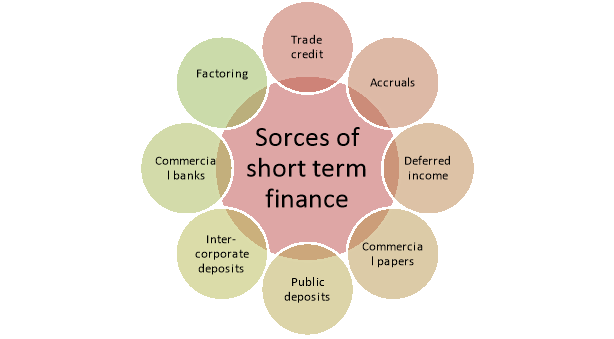
Figure: Sources of short term finance
1. Trade Credit:
Trade credit refers to the credit extended by the supplier of goods or services to his/her customer in the normal course of business. It occupies a very important position in short-term financing due to the competition. Almost all the traders and manufacturers are required to extend credit facility (a portion), without which there is no business. Trade credit is a spontaneous source of finance that arises in the normal business transactions without specific negotiation, (automatic source of finance).
2. Accruals:
Accrued expenses are those expenses which the company owes to the other, but not yet due and not yet paid the amount. Accruals represent a liability that a firm has to pay for the services or goods, it has received. It is spontaneous and interest-free source of financing. Salaries and wages, interest and taxes are the major constituents of accruals. Salaries and wages are usually paid on monthly and weekly base, respectively. The amounts of salaries and wages are owed but not yet paid and shown them as accrued salaries and wages on the balance sheet at the end of the financial year. The longer the time lag in–payment of these expenses, the greater is the amount of funds provided by the employees. Similarly, interest and tax are accruals, as source of short-term finance. Tax will be paid on earnings.
3. Deferred Income:
Deferred income is income received in advance by the firm for supply of goods or services in future period. This income increases the firm’s liquidity and constitutes an important source of short-term finance. These payments are not showed as revenue till the supply of goods or services, but showed in the balance sheet as income received in advance.
Advance payment can be demanded by firms which are having monopoly power, great demand for its products and services and if the firm is manufacturing a special product on a special order.
4. Commercial Papers (CPs):
Commercial paper represents a short-term unsecured promissory note issued by firms that have a fairly high credit (standing) rating. It was first introduced in the USA and it is an important money market instrument. In India, Reserve Bank of India introduced CP on the recommendations of the Vaghul Working Group on Money Market. CP is a source of short-term finance to only large firms with sound financial position.
5. Public Deposits:
Public deposits or term deposits are in the nature of unsecured deposits, are solicited by the firms (both large and small) from general public primarily for the purpose of financing their working capital requirements.
6. Inter-Corporate Deposits (ICDs):
A deposit made by one firm with another firm is known as Inter-Corporate Deposit (ICD). Generally, these deposits are made for a period up to six months.
Such deposits may be of three types:
(a) Call Deposits:
These deposits are those expected to be payable on call/on just one day notice. But, in actual practice, the lender has to wait for at least 2 or 3 days to get back the amount. Inter-corporate deposits generally have 12 per cent interest per annum.
(b) Three Months Deposits:
These deposits are more popular among companies for investing the surplus funds. The borrower takes this type of deposits for meeting short-term cash inadequacy. The interest rate on these types of deposits is around 14 per cent per annum.
(c) Six months Deposits:
Inter-corporate deposits are made for a maximum period of six months. These types of deposits are usually given to ‘A’ category borrowers only and they carry an interest rate of around 16 per cent per annum.
7. Commercial Banks:
Commercial banks are the major source of working capital finance to industries and commerce. Granting loan to business is one of their primary functions. Getting bank loan is not an easy task since the lending bank may ask a number of questions about the prospective borrower’s financial position and its plans for the future.
At the same time the bank will want to monitor borrower’s business progress. But there is a good side to this, that is borrower’s share price tends to rise, because investor knows that convincing banks is very difficult. The different types or forms of loans are:
(i) Loans,
(ii) Overdrafts,
(iii) Cash credits,
(iv) Purchasing or discounting of bills and
(v) Letter of Credit.
8. Factoring:
Factoring is one of the sources of working capital. Banks have been given more freedom of borrowing and lending both internally and externally and facilitated the free functioning in lending and investment operations. From 1994, banks are allowed to enter directly leasing, hire purchasing and factoring services, instead through their subsidiaries. In other words, banks are free to enter or exit in any field depending on their profitability, but subject to some RBI guidelines. Banks provide working capital finance through financing receivables, which is known as “factoring”. A “Factor” is a financial institution, which renders services relating to the management and financing of sundry debtors that arises from credit sales.
Key takeaways
- Short-term financing is aimed to meet the demand of current assets and pay the current liabilities of the organization. In other words, it helps in minimizing the gap between current assets and current liabilities.
Two components of capital are current assets and current liabilities. Estimation of the amount of current and current liabilities to maintain a certain level of operation is not an easy task. The lack of working capital disrupts the smooth production process, and excess working capital increases costs. Here we describe the estimation of working capital in case of trading and manufacturing concerns.
The following procedure should be employed to estimate working capital for manufacturing concerns:
(a) Expected production per week or per month.
(b) Determination of costs for each element, namely material, labour and overhead, as well as profit per unit;
(c) Calculation of the amount blocked for each week/month for each element of cost and profit;
(d) Determination of the operating cycle by estimating the raw material retention period. Processing time, storage period of finished products, debt collection period. The period of payment of creditor it takes time lag in pay and overhead payments.
(e) Determining the net block period. This is the period during which each element of the cost remains blocked. For example, if the raw material remains in the store for 2 weeks after purchase, the processing time is 2 weeks, the finished product remains in stock, 3 weeks if the credit period extended to the debtor is extended for 4 weeks, and the payment for the material is made for 2 weeks after purchase, the net block period is as follows: [(2+ 2 + 3 + 4) – (2)] = 9 a few weeks.
(f) Obtain the working capital requirements for each element of the cost by multiplying the net block period calculated in step (e) and the amount blocked for each element of the cost according to step (c).
(g) Get the total amount of working capital, if any, by summing up the costs and all the amounts calculated for each element of the desired cash.
Key takeaways
- Estimation of the amount of current and current liabilities to maintain a certain level of operation is not an easy task. The lack of working capital disrupts the smooth production process, and excess working capital increases costs. Here we describe the estimation of working capital in case of trading and manufacturing concerns.
Cash management is the process of collecting and managing cash flows. Cash management can be important for both individuals and companies. In business, it is a key component of a company's financial stability. For individuals, cash is also essential for financial stability while also usually considered as part of a total wealth portfolio. Individuals and businesses have a wide range of offerings available across the financial marketplace to help with all types of cash management needs. Banks are typically a primary financial service provider for the custody of cash assets. There are also many different cash management solutions for individuals and businesses seeking to obtain the best return on cash assets or the most efficient use of cash comprehensively.
Objectives of Cash Management
The objectives of cash management are discussed below-
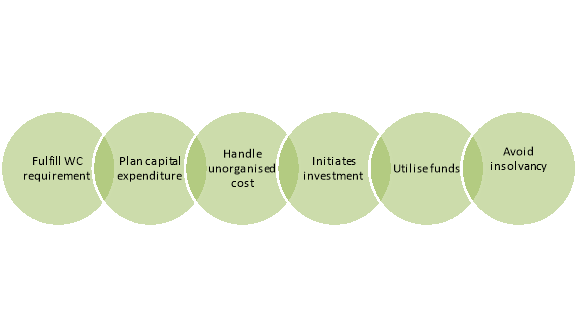
Figure: Objectives of cash management
- Fulfil Working Capital Requirement: The organization needs to maintain ample liquid cash to meet its routine expenses which possible only through effective cash management.
- Planning Capital Expenditure: It helps in planning the capital expenditure and determining the ratio of debt and equity to acquire finance for this purpose.
- Handling Unorganized Costs: There are times when the company encounters unexpected circumstances like the breakdown of machinery. These are unforeseen expenses to cope up with; cash surplus is a lifesaver in such conditions.
- Initiates Investment: The other aim of cash management is to invest the idle funds in the right opportunity and the correct proportion.
- Better Utilization of Funds: It ensures the optimum utilization of the available funds by creating a proper balance between the cash in hand and investment.
- Avoiding Insolvency: If the business does not plan for efficient cash management, the situation of insolvency may arise. It is either due to lack of liquid cash or not making a profit out of the money available.
Factors determining cash needs
Maintenance of optimum level of cash is the main problem of cash management. The level of cash holding differs from industry to industry, organisation to organisation. The factors determining the cash needs of the industry is explained as follows:
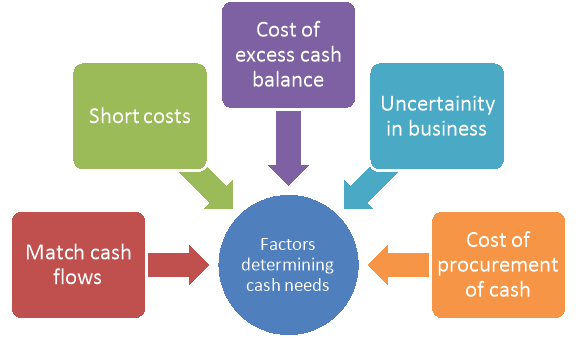
Figure: Factors determining cash needs
- Matching of cash flows:
The first and very important factor determining the level of cash requirement is matching cash inflows with cash outflows. If the receipts and payments are perfectly coinciding or balance each other, there would be no need for cash balances. The need for cash management therefore due to the non-synchronisation of cash receipts and disbursements.
Ii. Short costs:
Short costs are defined as the expenses incurred as a result of shortfall of cash. The short costs include, transaction costs associated with raising cash to overcome the shortage, borrowing costs associated with borrowing to cover the shortage i.e., interest on loan, loss of trade-discount, penalty rates by banks to meet a shortfall in cash balances and costs associated with deterioration of the firm’s credit rating etc. which is reflected in higher bank charges on loans, decline in sales and profits.
Iii. Cost of excess cash balances:
One of the important factors determining the cash needs is the cost of maintaining cash balances i.e., excess or idle cash balances. The cost of maintaining excess cash balance is called excess cash balance cost.
Iv. Uncertainty in business:
The first requirement of cash management is a precautionary cushion to cope with irregularities in cash flows, unexpected delays in collections and disbursements and defaults. The uncertainty can be overcome through accurate forecasting of tax payments, dividends, capital expenditure etc. and ability of the firm to borrow funds through over draft facility.
v. Cost of procurement and management of cash:
The costs associated with establishing and operating cash management staff and activities determining the cash needs of a business firm. These costs are generally fixed and are accounted for by salary, storage and handling of securities etc. The above factors are considered to determine the cash needs of a business firm
Cash Management Models
Cash management requires a practical approach and a strong base to determine the requirement of cash by the organization to meet its daily expenses. For this purpose, some models were designed to determine the level of money on different parameters.
The two most important models are discussed in detail below:
- The Baumol’s EOQ Model
Based on the Economic Order Quantity (EOQ), in the year 1952, William J. Baumol gave the Baumol’s EOQ model, which influences the cash management of the company. This model emphasizes on maintaining the optimum cash balance in a year to meet the business expenses on the one hand and grab the profitable investment opportunities on the other side. The following formula of the Baumol’s EOQ Model determines the level of cash which is to be maintained by the organization:

Where,
‘C’ is the optimum cash balance;
‘F’ is the fixed transaction cost;
‘T’ is the total cash requirement for that period;
‘i’ is the rate of interest during the period
2. The Miller – Orr’ Model
According to Merton H. Miller and Daniel Orr, Baumol’s model only determines the cash withdrawal; however, cash is the most uncertain element of the business. There may be times when the organization will have surplus cash, thus discouraging withdrawals; instead, it may require to make investments. Therefore, the company needs to decide the return point or the level of money to be maintained, instead of determining the withdrawal amount. This model emphasizes on withdrawing the cash only if the available fund is below the return point of money whereas investing the surplus amount exceeding this level.
Functions of Cash Management
Cash management is required by all kinds of organizations irrespective of their size, type and location. Following are the multiple managerial functions related to cash management:
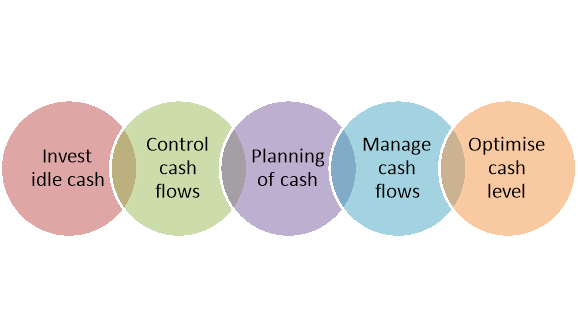
Figure: Functions of cash management
- Investing Idle Cash: The company needs to look for various short term investment alternatives to utilize surplus funds.
- Controlling Cash Flows: Restricting the cash outflow and accelerating the cash inflow is an essential function of the business.
- Planning of Cash: Cash management is all about planning and decision making in terms of maintaining sufficient cash in hand and making wise investments.
- Managing Cash Flows: Maintaining the proper flow of cash in the organization through cost-cutting and profit generation from investments is necessary to attain a positive cash flow.
- Optimizing Cash Level: The organization should continuously function to maintain the required level of liquidity and cash for business operations.
Key takeaways
- Cash management is the process of collecting and managing cash flows. Cash management can be important for both individuals and companies. In business, it is a key component of a company’s financial stability.
Account receivables refer to the outstanding invoices or money which is yet to be paid by your customers. Until it is paid, such invoices or money is accounted as accounts receivables. It is also known as bills receivables. Business need cash all the time to keep the business running smoothly and ensuring the accounts receivables are paid on time is essential to manage cash flow efficiently. Management of the accounts receivable is called receivable management. Basically, the entire process of defining the credit policy, setting payment terms, sending payment follow ups and timely collection of the due payments can be defined as receivables management. Management of Receivables is also known as:
- Payment Collection
- Collection Management
- Accounts Receivables
Nature of receivable management
The nature of receivable management is discussed below-
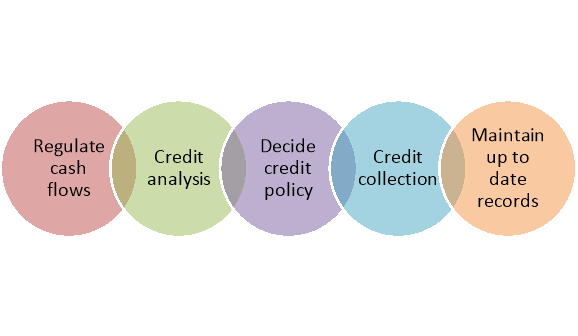
Figure: Nature of receivable management
- Regulate Cash Flow
Receivable management regulates all cash flows in an organization. It controls all inflow and outflow of funds and ensures that an efficient amount of cash is always available. Proper management of receivables enables organizations in efficient functioning at all the times.
2. Credit Analysis
It performs proper analysis of customer credentials for determining their credit ratings. Monitoring and scanning of customers before provide them any credit facility helps in minimizing the credit risk.
3. Decide Credit Policy
Receivable management decides the credit policy and standards as per which credit facility should be extended to customers. A company may have a lenient credit policy where customer credit-worthiness is not at all considered or a stringent policy where credit-worthiness is considered for providing credit.
4. Credit Collection
Receivable management focuses on efficient and timely collection of business payments from its customers. It works towards reducing the time gap in between the moments when bills are raised and payment is collected.
5. Maintain Up-To-Date Records
Receivable management maintains a systematic record of all business transactions on a regular basis. All transactions are maintained fairly in the form of proper billing and invoices which helps in avoiding any confusion or settling of disputes arising later.
Functions of receivable management
The functions of receivable management are discussed below-
- Evaluates Customer Credit Ratings
Receivable management evaluates its customers borrowing capacity and repaying ability for determining their credit ratings. It approves any credit facility to its customers after analysing their information both qualitatively and quantitatively. Proper investigation of client details helps in reducing the credit risk.
2. Minimizes Investment in Receivables
It reduces investment in receivable by ensuring optimum funds are available within organization at all the times. Receivable management decides proper credit limit and credit period for avoiding any bankruptcy situations. Attempts are made to collect account receivable as soon as they become due for payment which reduces the overall investment in receivables.
3. Optimize Sales
Efficient receivable management assist business in raising their sales volume. Business is able to attract more and more customers by providing them credit facilities. They are able to properly decide and monitor credit facilities with the help of a receivable management.
4. Reduce Risk of Bad Debts
It takes all steps to avoid any instances of bad debts. Receivable management notify all customers for the payment as soon as the amount gets due. It charges interest on delay payments and aims at optimum collection of all payment timely.
5. Maintain Efficient Cash
Maintenance of efficient cash is crucial for the survival of every organization. Receivables management properly records all cash inflows and outflows of a business. All credit facilities are extended after analysing the capability of organization and due payments are collected timely. This results in steady cash flow within the organization.
6. Lower Cost of Credit
Receivable management helps business in lowering its cost of credit by limiting the credit amount and credit period for its customers. It performs all processes such as acquiring credit information of clients and collecting all due payments in an efficient way which lower the overall cost associated with credit facilities.
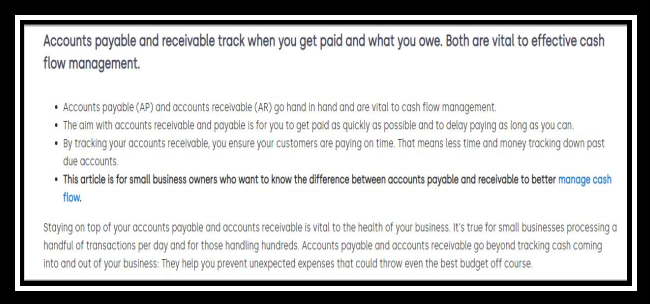
Key takeaways
- Account receivables refer to the outstanding invoices or money which is yet to be paid by your customers. Until it is paid, such invoices or money is accounted as accounts receivables. It is also known as bills receivables.
Inventory constitutes an important item in the working capital of many business concerns. Net working capital is the difference between current assets and current liabilities. Inventory is a major item of current assets. The term inventory refers to the stocks of the product a firm is offering for sale and the components that make up the product. Inventory is stores of goods and stocks. This includes raw materials, work-in-process and finished goods. Raw materials consist of those units or input which are used to manufacture goods that require further processing to become finished goods. Finished goods are products ready for sale. The classification of inventory and the levels of the components vary from organisation to organisation depending upon the nature of business. For example, steel is a finished product for a steel industry, but raw material for an automobile manufacturer. Thus, inventory may be defined as “Stock of goods that is held for future use”. Since inventory constitute about 50 to 60 percent of current assets, the management of inventories is crucial to successful Working Capital Management. Working capital requirements are influenced by inventory holding. Hence, there is a need for effective and efficient management of inventory A good inventory management is important to the successful operations of the most of the organizations, unfortunately the importance of inventory is not always appreciated by top management. This may be due to a failure to recognize the link between inventory and achievement of organisational goals or due to ignorance of the impact that inventory can have on costs and profits. Inventory management refers to an optimum investment in inventory. It should neither be too low to effect the production adversely nor too high to block the funds unnecessarily. Excess investment in inventory is unprofitable for the business. Both excess and inadequate investment in inventory is not desirable. The firm should operate within the two danger points. The purpose of inventory management is to determine and maintain the optimum level of inventory investment. Techniques and Tools of Inventory Control:
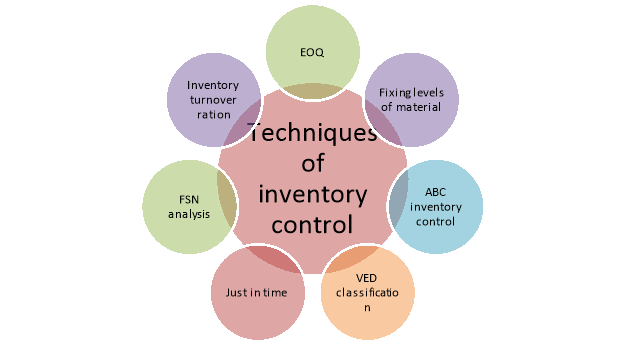
Figure: Techniques of inventory control
- Economic Order Quantity
The economic order quantity (EOQ) refers to the ideal order quantity a company should purchase in order to minimize its inventory costs, such as holding costs, shortage costs, and order costs. EOQ is necessarily used in inventory management, which is the oversight of the ordering, storing, and use of a company's inventory. Inventory management is tasked with calculating the number of units a company should add to its inventory with each batch order to reduce the total costs of its inventory.
Formula for EOQ
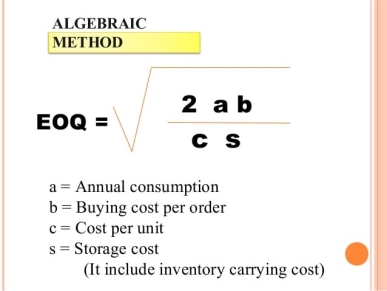
2. Fixing Levels of Material.
(a) Minimum Level
This represents the quantity which must be maintained in hand at all times. If stocks are less than the minimum level, then the work will stop due to shortage of materials. Following factors are taken into account while deciding minimum stock level:
(i) Lead Time:
A purchasing firm requires some time to process the order and time is also required by the supplier/vendor to execute the order. The time taken in processing the order and then executing it is known as lead time. It is essential to maintain some inventory during this period to meet production requirements.
(ii) Rate of Consumption:
It is the average consumption of materials items in the industry. The rate of consumption will be decided on the basis of past experience and production plans.
(iii) Nature of Material:
The nature of material also affects the minimum level. If a material is required only against special orders of the customer, then minimum stock will not be required for such materials. Wheldon has given the following formula for calculating minimum stock level:
Minimum stock Level = Re-ordering Level – (Normal Consumption x Normal Reorder Period)
(iv) Re-ordering Level:
When the quantity of materials reaches a certain level then fresh order is sent to procure materials again. The order is sent before the materials reach minimum stock level.
(b) Maximum Level
It is the quantity of materials beyond which a firm should not exceed its stocks. If the quantity exceeds maximum level limit, then it will be termed as overstocking. A firm avoids overstocking because it will result in high material costs. Overstocking will lead to the requirement of more capital, more space for storing the materials, and more charges of losses from obsolescence. Maximum stock level will depend upon the following factors:
1. The availability of capital for the purchase of materials in the firm.
2. The maximum requirements of materials at any point of time.
3. The availability of space for storing the materials as inventory.
4. The rate of consumption of materials during lead time.
5. The cost of maintaining the stores.
6. The possibility of fluctuations in prices of various materials.
7. The nature of materials. If the materials are perishable in nature, then they cannot be stored for long periods.
8. Availability of materials. If the materials are available only during seasons, then they will have to be stored for the future period.
9. Restrictions imposed by the government. Sometimes, government fixes the maximum quantity of materials which a concern can store. The limit fixed by the government will become the deciding factor and maximum level cannot be fixed more than that limit.
10. The possibility of changes in fashions will also affect the maximum level.
It is calculated as-
Maximum Stock Level = Reordering Level + Reordering Quantity – (Minimum Consumption x Minimum Reordering period)
(c) Danger Level
It is the level below which stocks should not fall in any case. If danger level approaches, then immediate steps should be taken to replenish the stocks even if more cost is incurred in arranging the materials. Danger level can be determined with the following formula:
Danger Level = Average Consumption x Maximum reorder period for emergency purchases.
3. ABC Inventory Control
ABC method of inventory control involves a system that controls inventory and is used for materials and throughout the distribution management. It is also known as selective inventory control or SIC. ABC analysis is a method in which inventory is divided into three categories, i.e. A, B, and C in descending value. The items in the A category have the highest value, B category items are of lower value than A, and C category items have the lowest value.
Need for Prioritizing Inventory
Item A:
In the ABC model of inventory control, items categorized under A are goods that register the highest value in terms of annual consumption. It is interesting to note that the top 70 to 80 per cent of the yearly consumption value of the company comes from only about 10 to 20 per cent of the total inventory items. Hence, it is crucial to prioritize these items.
Item B:
These are items that have a medium consumption value. These amounts to about 30 per cent of the total inventory in a company which accounts for about 15 to 20 per cent of annual consumption value.
Item C:
The items placed in this category have the lowest consumption value and account for less than 5 per cent of the annual consumption value that comes from about 50 per cent of the total inventory items.
4. Perpetual Inventory System
A perpetual inventory system is an inventory management method that records when stock is sold or received in real-time through the use of an inventory management system that automates the process. A perpetual inventory system will record changes in inventory at the time of the transaction. A perpetual inventory system works by updating inventory counts continuously as goods are bought and sold. This inventory accounting method provides a more accurate and efficient way to account for inventory than a periodic inventory system. Here is a step-by-step overview of how this type of inventory system works.
5. VED classification.
VED analysis is an inventory management technique that classifies inventory based on its functional importance. It categorizes stock under three heads based on its importance and necessity for an organization for production or any of its other activities. VED analysis stands for Vital, Essential, and Desirable.
- V-Vital category
As the name suggests, the category “Vital” includes inventory, which is necessary for production or any other process in an organization. The shortage of items under this category can severely hamper or disrupt the proper functioning of operations. Hence, continuous checking, evaluation, and replenishment happen for such stocks. If any of such inventories are unavailable, the entire production chain may stop. Also, a missing essential component may be of need at the time of a breakdown. Therefore, order for such inventory should be before-hand. Proper checks should be put in place by the management to ensure the continuous availability of items under the “vital” category.
- E- Essential category
The essential category includes inventory, which is next to being vital. These, too, are very important for any organization because they may lead to a stoppage of production or hamper some other process. But the loss due to their unavailability may be temporary, or it might be possible to repair the stock item or part.
The management should ensure optimum availability and maintenance of inventory under the “Essential” category too. The unavailability of inventory under this category should not cause any stoppage or delays.
- D- Desirable category
The desirable category of inventory is the least important among the three, and their unavailability may result in minor stoppages in production or other processes. Moreover, the easy replenishment of such shortages is possible in a short duration of time.
6. Just-In-Time
Just in time is a form of inventory management that requires working closely with suppliers so that raw materials arrive as production is scheduled to begin, but no sooner. The goal is to have the minimum amount of inventory on hand to meet demand.
7. FSN Analysis
FSN stands for fast-moving, slow-moving and non-moving items. The basis of FSN analysis is to derive vital data to help guide inventory management decisions. These may include where products should be placed in the warehouse. For example, fast-moving items could be placed in a location that is easily accessible.
- Fast-moving inventory
Fast-moving inventory comprises of inventory, which moves in and out of stock fastest and most often. Therefore, these goods have the highest replenishment rate. Items in this category generally comprise less than 20% of the total inventory.
- Slow-moving inventory
Items in this category move slower, and hence, their replenishment is also slower. This category comprises of around 35% of the total inventory in an organization.
- Non- moving inventory
The last category of this analysis is the least moving portion of the inventory and also includes the dead stock. Replenishment of such inventory may or may not take place at all after utilization. This category can go as high as 55%-60% of the total inventory in organizations.
8. Inventory Turnover Ratio
Inventory turnover is a financial ratio showing how many times a company has sold and replaced inventory during a given period. A company can then divide the days in the period by the inventory turnover formula to calculate the days it takes to sell the inventory on hand. Calculating inventory turnover can help businesses make better decisions on pricing, manufacturing, marketing, and purchasing new inventory.

Key takeaways
- The term inventory refers to the stocks of the product a firm is offering for sale and the components that make up the product.
Case study
A Case Study on Working Capital Management of Bajaj Auto Ltd.
Bajaj Auto Ltd is a flagship of Bajaj Group which is amongst the top 10 business houses in India. Bajaj Auto is the world's third-largest manufacturer of motorcycles and the second-largest in India It is the world’s largest three-wheeler manufacturer.
Bajaj Auto came into existence on 29 November 1945 as M/s Bachraj Trading Corporation Private Limited It started off by selling imported two- and three-wheelers in India. In 1959, it obtained a license to manufacture two-wheelers and three-wheelers and it became a public limited company in 1960. In 1970, it rolled out its 100,000th vehicle. In 1977, it sold 100,000 vehicles in a financial year. In 1985, it started producing at Waluj near Aurangabad.
It was founded by Jamnalal Bajaj in Rajasthan in the 1930s. It is based in Pune, Mumbai, with plants in Chakan (Pune), Waluj (near Aurangabad) and Pantnagar in Uttarakhand. The oldest plant at Akurdi (Pune) now houses the R & D centre 'Ahead'.
On 31 March 2013, its market capitalization was INR 520 billion (US$9.57 billion), making it India's 23rd largest publicly traded company by market value. With the launch of motorcycles in 1986, the company has changed its image from a scooter manufacturer to a two-wheeler manufacturer.
According to the authors of Globality: Competing with Everyone from Everywhere for Everything, Bajaj has operations in 50 countries by creating a line of bikes targeted to the preferences of entry-level buyers.
Bajaj Auto Ltd., incorporated in the year 2007, is a Large Cap company (having a market cap of Rs 58,491.2 Cr.) operating in Auto sector.
Bajaj Auto Ltd. Key Products/Revenue Segments include Automobile - Vehicles which contributed Rs 18800.53 Cr to Sales Value (88.85% of Total Sales), Auto Spare Parts (Trading) which contributed Rs 1659.97 Cr to Sales Value (7.84% of Total Sales), Export Incentives which contributed Rs 335.94 Cr to Sales Value (1.58% of Total Sales), Auto Spare Parts which contributed Rs 241.97 Cr to Sales Value (1.14% of Total Sales), Scrap which contributed Rs 54.82 Cr to Sales Value (0.25% of Total Sales), Royalty Income which contributed Rs 40.59 Cr to Sales Value (0.19% of Total Sales), Vehicles - Trading Items which contributed Rs 24.57 Cr to Sales Value (0.11% of Total Sales), Other Operating Revenue which contributed Rs 0.52 Cr to Sales Value (0.00% of Total Sales), for the year ending 31-Mar-2014.
For the quarter ended 31-Dec-2014, the company has reported a Standalone sale of Rs. 5520.01 Cr., down -5.27% from last quarter Sales of Rs. 5826.85 Cr. And up 9.86% from last year same quarter Sales of Rs. 5024.76 Cr. Company has reported net profit after tax of Rs. 861.24 Cr. In latest quarter.
Bajaj Auto with its strong brand image and other competency features maintained dominant position in India. Year on year the company increased production size and attained economies of scale.
Working Capital
Working Capital is that which is required to operate routine business activities. It reflects the liquidity position of the company. Working capital is excess of current assets over current liabilities. Current assets include cash, bank balance, marketable securities, inventories and receivables whereas current liabilities include creditors, bills payable and provisions. Working capital has great influence on profitability and solvency. As we increase the liquidity the profitability will be effected and if we decrease it the solvency will be effected.
Working Capital of Bajaj Auto Ltd. Is given below:
Current Assets | Mar’2014 | Mar’2013 | Mar’2012 | Mar’2011 | Mar’2010 |
Inventories | 639.72 | 636.28 | 678.53 | 547.28 | 446.21 |
Sundry Debtors | 796.21 | 767.58 | 423.20 | 362.76 | 272.84 |
Cash and Bank Balance | 495.48 | 558.86 | 446.49 | 155.45 | 100.20 |
Total Current Assets | 1,931.41 | 1,962.72 | 1,548.22 | 1,065.49 | 819.25 |
Loans and Advances | 2,116.46 | 1,987.44 | 1,744.82 | 3,891.66 | 2,291.29 |
Fixed Deposits | 0.00 | 0.00 | 1,208.36 | 401.04 | 1.21 |
Total CA, Loans & Advances | 4,047.87 | 3,950.16 | 4,501.40 | 5,358.19 | 3,111.75 |
Current Liabilities | 3,108.15 | 2,762.93 | 2,925.53 | 2,624.35 | 2,218.06 |
Provisions | 1,973.69 | 1,742.47 | 2,174.89 | 3,925.72 | 2,248.72 |
Total CL & Provisions | 5,081.84 | 4,505.40 | 5,100.42 | 6,550.07 | 4,466.78 |
Net Current Assets | -1,033.97 | -555.24 | -599.02 | -1,191.88 | -1,355.03 |
References:
1. Bhalla V.K – Financial Management – S.Chand.
2. Horne, J.C. Van and Wackowich. Fundamentals of Financial Management. 9thed. New Delhi Prentice Hall of India.
3. Johnson, R.W. Financial Management. Boston Allyn and Bacon.
4. Joy, O.M. Introduction to Financial Management. Homewood: Irwin.
5. Khan and Jain. Financial Management text and problems. 2nd ed. Tata McGraw Hill New Delhi.
6. Pandey, I.M. Financial Management. Vikas Publications.
7. Chandra, P. Financial Management- Theory and Practice. (Tata McGraw Hill).
8. Rustagi, R.P. Fundamentals of Financial Management. Taxmann Publication Pvt. Ltd.
9. Singh, J.K. Financial Management- text and Problems. 2nd Ed. DhanpatRai and Company, Delhi.
10. Singh, Surender and Kaur, Rajeev. Fundamentals of Financial Management. Book Bank International.
11. Brigham and Houston, Fundamentals of Financial Management, 13th Ed., Cengage Learning.